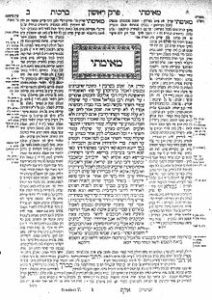A Tale of Two Talmuds, BAR 17:02, Mar-Apr 1991.
 The Talmud is the great work of rabbinic law and lore produced in the aftermath of the Roman destruction of the Jerusalem Temple in 70 C.E. The Talmud has two parts, the Mishnah, a code of law compiled by Rabbi Judah ha-Nasi (the Prince) about 200 C.E., and the Gemara (sometimes itself referred to as the Talmud), the record of the extensive discussions over the meaning of the Mishnah that took place in rabbinic academies. To make things a bit confusing, the Gemara with the Mishnah exists in two versions—one the product of the academies in Babylon and the other of the schools in Israel. The former, compiled about 500 C.E., is called the Babylonian Talmud and the latter, compiled about a century earlier, is called the Jerusalem, or Palestinian, Talmud.
The Talmud is the great work of rabbinic law and lore produced in the aftermath of the Roman destruction of the Jerusalem Temple in 70 C.E. The Talmud has two parts, the Mishnah, a code of law compiled by Rabbi Judah ha-Nasi (the Prince) about 200 C.E., and the Gemara (sometimes itself referred to as the Talmud), the record of the extensive discussions over the meaning of the Mishnah that took place in rabbinic academies. To make things a bit confusing, the Gemara with the Mishnah exists in two versions—one the product of the academies in Babylon and the other of the schools in Israel. The former, compiled about 500 C.E., is called the Babylonian Talmud and the latter, compiled about a century earlier, is called the Jerusalem, or Palestinian, Talmud.
The name Jerusalem Talmud, however, is a misnomer. It was produced not in Jerusalem but primarily in the academies at Caesarea, Sepphoris and—above all—Tiberias. For that reason, it is sometimes called the Talmud of the Land of Israel or the Talmud of the West (to distinguish it from Babylon, in the East). The leading talmudic scholar in Tiberias was Rabbi Yohanan, and it is his Beth Midrash (study house) that Yizhar Hirschfeld believes has now been unearthed. So crucial was Rabbi Yohanan’s contribution to the Western Talmud that Maimonides (1135–1204), one of the greatest of the medieval talmudic authorities, credits him with compiling the entire work. That this could not have been the case, however, is seen from the fact that scholars who lived after Rabbi Yohanan are quoted in the Talmud.
The Jerusalem Talmud is not as extensive as its Babylonian counterpart, but it does contain volumes not present in the Babylonian collection, discussing agricultural laws that applied to the land of Israel and issues related to Temple activities. On the matter of the Temple, it might well be that hopes for its imminent rebuilding were more vivid among the inhabitants of Israel than among the exiles in Babylon.
Beginning in the eighth century, the authority of the Babylonian Talmud spread to most Jewish communities outside of Israel. Rabbi Hai Gaon (d. 1038) decreed that the decisions of the Babylonian Talmud took precedence over the Jerusalem Talmud where the two were in conflict. Ever since, the Jerusalem Talmud has been the poor relation in talmudic studies, of interest primarily to specialists.
This article is a sidebar to Tiberias- Preview of Coming Attractions, Yizhar Hirschfeld, BAR 17-02, Mar-Apr 1991.



